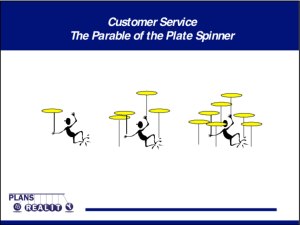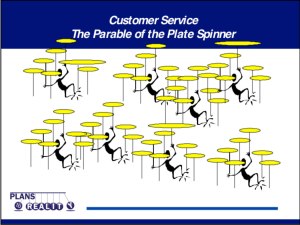 If I were to ask you to jot down a list of the factors that result in great execution, I’m quite sure that leadership, goals, teamwork, change management, communication and employee engagement would feature prominently on your list. But if we all know the basics of what is required to achieve great execution, why is the standard of execution so mediocre?
If I were to ask you to jot down a list of the factors that result in great execution, I’m quite sure that leadership, goals, teamwork, change management, communication and employee engagement would feature prominently on your list. But if we all know the basics of what is required to achieve great execution, why is the standard of execution so mediocre?
The answer is twofold. We don’t have a defined process and we neglect the human side of planning. We are so desperate to put the plan into action that we convince ourselves that the sooner we begin to execute, the sooner our organisation will experience the plan’s projected benefits.
Developing any plan or business strategy is made up of three phases.
■ Phase 1 – this is what we want to do
■ Phase 2 – this is how we are going to do it
■ Phase 3 – the initial Action Plan – based on Phase 2, not Phase 1
Each of these phases has a human dimension which if neglected will seriously compromise the plan’s execution.
Phase 1 – This is what we want to do
This phase of the planning process is usually put together by a core group of planners. However, even at this stage there is a human dimension – two in fact.
1) The planners need to explain the rationale behind the plan – this is what we want to do because ………. If you are going to ask your staff to make changes – of whatever kind – that are necessary to implement the plan, you have to explain the rationale behind those changes.
2) The planning under Phase 1 must result in an overall goal to which everyone in the organisation can relate. The goal must represent a collective challenge – everyone from the CEO to the receptionist should feel that they have a part to play in its achievement. It should have a competitive element, an external, customer focus and its achievement will only be possible if everyone works together.
Phase 2 – This is how we are going to do it
In most planning, the time spent by the planners on Phase 1 far exceeds the time spent considering and planning for Phase 2. Incorporating the human dimension is of paramount importance if the plan is to be effectively executed. This is what you need to do.
3) Enlarge the planning team to include those who will be responsible for the plan’s execution. There is a saying that the more people who plan the battle, the less there are to battle the plan. Bringing the implementers on board at this stage of the planning process will result in these benefits:
■ Those charged with the execution of the plan are better equipped to consider its implications on the support functions within the organisation. If aspects of the plan are unachievable or inappropriate, now’s the time to revise the plan, not six months down the track when the barriers to execution become apparent.
■ Involving those who will be charged with the plan’s execution will enhance Oganisational Alignment – the key to effective execution.
■ Their involvement marks the commencement of joint ownership of the Plan between planners and implementers.
■ You will end up with a better plan.
4) If the plan is a strategic one with major implications for the organisation, its implementation may require an organisational restructuring. Nothing is more likely to raise staff concerns – and potential antagonism to the plan – than change that impacts people’s jobs and roles. But note the following. Only 5 – 10% of your staff will actively oppose such restructuring. The bulk of your staff – 70% – will accept change, given a rational and convincing reason to do so. That’s why Human Dimension No.1 is so important.
Phase 3 – The initial Action Plan – based on Phase 2, not Phase 1
When I talk to people about implementation, there is always much nodding of heads when Human Dimension No. 5 is tabled.
5) Management underestimated the time required for implementation – those charged with its implementation did not have enough hours in the day to complete the actions they were responsible by the date indicated and do their “normal” jobs at the same time.
When you take into account the human dimensions of planning, you lay the foundation stone of great execution – Organisational Alignment. There are two dimensions to Organisational Alignment. The first is the ability of the planners to match the resources and capabilities of the organisation to the environment in which the organisation operates – now and in the future. This is the technical dimension – and it’s the focus of the planners on achieving this aspect of Organisational Alignment that frequently blinds them to the second – human – dimension. No plan can be successfully executed unless –
6) Everyone understands where the organisation is “now”. If this is not the case, it will result in varying levels of commitment to the plan’s implementation
7) Staff need to know, not only what their role is, but how it fits into the ‘big Picture’. This is what gives staff meaning and context to their jobs.
8) Staff need to know and understand what others’ roles are. Organisational Alignment takes place at three levels – individual, within workgroups and between workgroups.
When the human side of planning has been embraced in the planning process –
■ Everyone will understand where the organisation is now
■ Everyone will understand the destination and the journey
■ Everyone will understand their role in getting there
If you give the human side of planning the attention it warrants, you will find that those execution factors such as change management, leadership, teams and teamwork, employee engagement, monitoring, measuring and adapting will be a whole lot easier to manage. Not only will the execution of the plan achieve its objectives but the overall elapsed time from the commencement of planning to the completed roll-out of the plan will be less than is the case when management rushes headlong into execution and treats planning and implementation as two separate activities.
Graham Haines is the principal of Plans to Reality, a consultancy that specialises in the issues of implementation. His most recent book – “Achieving Execution to Die For – a Simple Guide to Making It Happen” – condenses the complete operational cycle from planning and execution to monitoring, measuring and modifying into a mere 18,500 words, taking an hour to read. It also identifies 36 barriers to great execution and how to overcome them. The book is available in hard and soft copy from his web site – http://www.planstoreality.com.au – and you can download the first section of the book – “The Purpose of this Guide and how to use it” for free.



 Posted by planstoreality
Posted by planstoreality 












